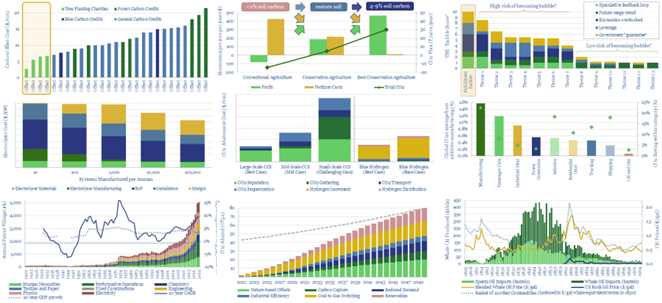We published 250 new research notes and data-files on our website in 2020. The purpose of this review is to highlight the ‘top ten’ reports. This includes our economic roadmap to reaching ‘Net Zero’, the greatest risks and opportunities that we have found in the transition, and the analysis that has most shaped our views.
(1) The single most powerful decarbonization option in all of our work is reforestation. Costs are as low as $3-10/ton. There is 15GTpa of carbon-offsetting potential (note here). But this is not an investment. It is an act of charity. It matters because increasing numbers of decision-makers are choosing to restore nature and offset their CO2 at low cost, rather than purchasing higher-cost new energies, which could make them uncompetitive.
(2) Restoring soil carbon is equally powerful, and surprisingly fascinating. Agricultural soil has lost three-quarters of its carbon since pre-industrial times. Restoring it could offset another 3-15GTpa of CO2. With a $30/ton CO2 price, mid-Western farmers could make more money farming carbon than corn. The theme would also disrupt the global fertilizer industry.
(3) Is energy transition becoming a bubble? If you read a single piece of research on energy transition this year, I would recommend this one. We fear an “investment bubble” is forming in the energy transition space. Half of all transition technologies we have evaluated are on the “wrong” side of the cost curve and may be displaced by the nature based solutions we described above.. Deflation and profitability are often antagonistic. And some spaces have seen incredible run-ups despite challenging economics and overlooked technical challenges. The purpose of this note is to suggest pragmatic responses.
(4) The green hydrogen economy may be the largest bubble. Our work this year has assessed the theme in detail, both in power markets and as a transportation fuel. Costs are immutably high. This is due to the laws of physics and thermodynamics. Transporting green hydrogen will also be more challenge than any other commodity in history (note here). The note below is the best overview of our work. Many expect c80% deflation in the total costs of electrolysers. Our data suggest this is impossible. We welcome challenges to these numbers, but so far, have not received any from our contacts in the hydrogen industry.
(5) The green hydrogen bubble will give way to blue. Blue hydrogen is not just a low-carbon fuel. More importantly, it is the most economic and practical route to establishing large-scale carbon capture and storage. Economics are 80-90% superior to green hydrogen. Risks are materially lower. Our research note ends by identifying projects that should reach FID in 2021, and a public company with a clear ‘moat’ in the space.
(6) Non-obvious opportunities. Other novel technologies have a vast role in the route to Net Zero. The non-obvious opportunities are best, and are not at risk of becoming bubbles. Our research has covered many examples in 2020: deep geothermal, supercapacitors eclipsing batteries, industrial efficiency initiatives such as fully subsea offshore or next-generation refining; and backing up renewables with CHPs, PCMs and smart energy systems. If you read one research note into a non-obvious opportunity, we recommend this deep-dive below into additive manufacturing, which will re-shape every industry globally.
(7) Patent analysis can give you an edge identifying opportunities in the energy transition and, and avoiding hidden risks, particularly as bubbles build. Our note below lays out six themes, including worked examples, based on reviewing over 1M patents.
(8) Our most economic roadmap to Net Zero ties together all of our work. We find it is possible to decarbonize global energy by 2050, even as global energy demand rises by 65%. The total cost of decarbonization is $50trn, which is almost halved versus last year’s estimate in December-2019. The fully decarbonized energy system still contains 85Mbpd of oil and 375TCF per year of natural gas.
(9) Oil and gas are heading for devastating under-supply if our analysis is correct. This is historically precedented during technology transitions. Below we have evaluated supply-demand and pricing in the whale oil industry from 1805-1905, as it was disrupted by rock oil and later by electric lighting. Whale oil prices outperformed over this timeframe, as supply peaked before demand. Our latest our oil market outlook is here, and our gas market outlook is here.
(10) The optimal strategy for incumbent energy companies is thus suggested in our research note below. We argue that Energy Majors embracing these principles can uplift their valuations by c50% (assuming flat commodity prices).

